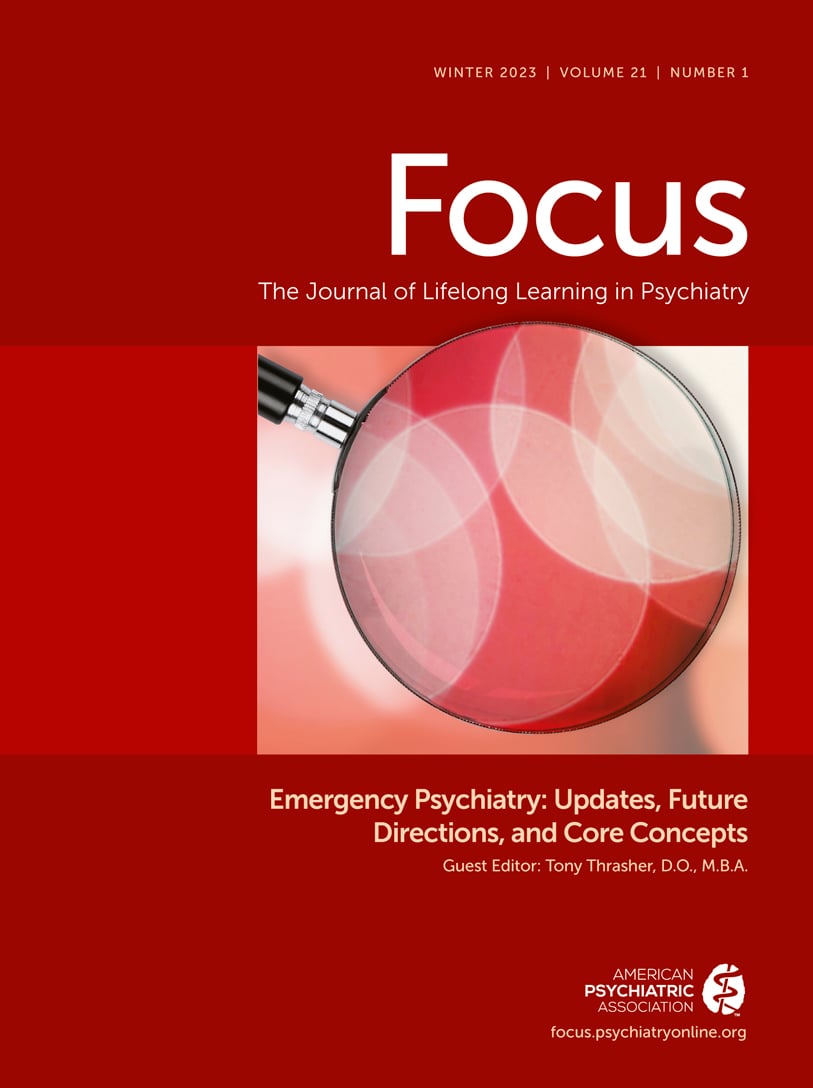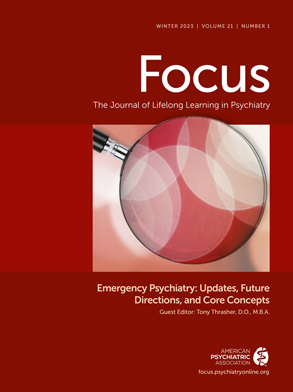This article is a clinical update of the 2017 expert consensus documents originally created by the American Association for Emergency Psychiatry (AAEP) on medical evaluation of the adult psychiatric patient in the ED (
7,
8). In particular, this article incorporates some of the recommendations from evidence-based literature after 2017, including the largest systematic review on this topic to date (
9), a clinical policy statement by the American College of Emergency Physicians (ACEP) (
12), and a review and recommendations by the Wisconsin Task Force on medical screening (
13). The review below details the process of medical evaluation for adult ED patients only and does not discuss other literature related to management of acute psychiatric conditions, such as screening of children (
14), management of patients with thoughts of self-harm (
15), or treatment of substance use disorders (
16,
17).
Medical Screening for Stability
In 1979, Weissberg (
18) presciently wrote that “The use of the label ‘medically clear’ in emergency room settings hinders patient care by impeding the flow of information between psychiatric and nonpsychiatric personnel.” This may be in part because the term has been variously used to signify either that no medical conditions were identified during medical evaluation or that no medical conditions requiring treatment in the ED or inpatient setting were identified during the medical evaluation (
7). Given this confusion, a 2017 AAEP task force proposed removing the term “medically clear” entirely (
8). In 2019, a Wisconsin task force representing both emergency physicians and psychiatrists agreed with this recommendation and proposed a novel term “medical stability” (
13). Importantly, medical stability includes not only identification of medical conditions that might be contributing to the presenting psychiatric symptoms but also the ability of providers to continue care for the patient after ED disposition. Consequently, the threshold for ensuring medical “stability” may vary depending on where the patient is dispositioned. In other words, patients being transferred to an outpatient freestanding psychiatric hospital may require more testing than patients being admitted to an inpatient psychiatric unit where medical consultation is readily available.
This lack of a fixed definition for medical stability may cause occasional conflict with ED physicians. Many ED studies in this domain have concluded that most ED evaluations are either unneeded or rarely change ED disposition (
19–
21). Unfortunately, the majority of these studies were either designed as retrospective chart reviews (
20) or have other methodological limitations (
9), meaning that the conclusions may not be generalizable. Nonetheless, given that ACEP devoted part of a recent clinical guideline to the lack of utility of laboratory testing for psychiatric patients in the ED setting (
12), consulting psychiatrists may occasionally encounter ED physicians who are passionate about reducing testing for psychiatric patients. Because not all patients presenting with psychiatric symptoms would benefit from such routine testing, it may be wise to develop an agreed-upon protocol in advance (see “Contemporary Principles of Medical Screening” section). In the absence of an agreed-upon protocol, psychiatric facilities might need to explicitly ask for studies that are thought to be necessary, especially if these tests are not available in a freestanding psychiatric facility.
Medical Screening Protocols
Despite the relative importance of medical screening of psychiatric patients for the field, there has been a surprising lack of rigorous prospective research (see also “Contemporary Principles of Medical Screening” section). Unfortunately, only four medical screening algorithms have been proposed in the literature (
45–
48). All have been designed for EDs transferring patients to outpatient psychiatric receiving facilities, and all have scant empiric support. The first medical screening protocol by Zun and Downey (
45) asks five questions:
•
Does the patient have a new psychiatric condition?
•
Any history of medical illness needing evaluation?
•
Any abnormal vital signs (temperature >101F, pulse <50 or >120, blood pressure (BP) <90 systolic or >200/120, or respiratory rate (RR) >24 breaths per minute?
•
Any abnormal physical exam findings (absence of limb, acute or chronic trauma, breath sounds, cardiac dysrhythmia, skin or vascular signs, abdominal distention, neurological exam)?
•
Any abnormal mental status indicating medical illness?
If the answer is “no” to all questions, no further medical workup is needed. Using this protocol, Zun and Downey calculated that the total cost decreased by $83 per patient, although the protocol did not reduce throughput time. Returns to the ED were not measured.
In a second screening protocol, Shah et al. (
46) created a different set of five questions that were adapted from the Zun and Downey protocol:
•
Does the patient have stable vital signs (temperature <100.5F, heart rate (HR) 50–119, RR <25, diastolic BP <120, pulse oximetry >94%)?
•
Does the patient have a prior psychiatric history or age <30?
•
Is the patient oriented × 4 (person, place, time, and situation) or with a Folstein Mini Mental State Exam score >23?
•
Is there no evidence of an acute medical problem?
•
Are there no visual hallucinations?
If the answer to all five questions is “yes,” the patient does not require further medical workup. In a subsequent chart review of 485 patients, Shah et al. (
46) found that the screening tool was inappropriately used in three patients and that an additional 12 required further medical workup after ED disposition. Ten of these patients had “no significant findings”; however, this means that approximately 3.1% of patients required further medical workup after application of the tool. This study is notable for a description of the 12 missed cases, but it is unfortunately limited by poor description of the methods, including an unclear description of how the charts for the ED and psychiatric receiving service were searched.
In a third screening protocol, Miller et al. (
47) created a triage algorithm for psychiatric screening (TAPS). This protocol was designed to be used at ED triage and asks six questions:
•
Abnormal vital signs (temperature >100.4F, HR >100 or <60, systolic BP >180 or <100, diastolic BP >100 or <60, RR <10 or >24)?
•
Patient has a medical problem as a chief complaint?
•
Hallucinations or delusions with no prior history of the same?
•
Schizophrenia or intellectual disability history?
•
Visibly intoxicated or admits to drug or alcohol use within the past 8 hours?
If the answer to all questions is “no,” the patient may be sent directly to the emergency behavioral health unit (the institution’s version of a psychiatric ED). The study was methodologically limited, because investigators were able to review only 100 charts from 825 TAPS-negative patients (12%), and seven of these charts were subsequently lost from this cohort (four were incorrectly filled out, two had data extraction errors, and one patient left the waiting room before further assessment). Finally, returns to the medical ED were not measured, and it is unknown how the tool would perform in a facility without immediately available resources for providing medical care.
Finally, in a fourth medical protocol (
48), Thomas and colleagues created the SMART Medical Clearance Form. SMART is as an acronym for the steps required in medical screening:
•
Suspect new-onset psychiatric condition?
•
Medical conditions that require screening (diabetes, possibility of pregnancy, other complaints that require screening)?
•
Abnormal vital signs (temperature >100.4F, HR <50 or >100, BP <100 systolic or >180/110 on two consecutive readings 15 minutes apart, RR <8 or >22, oxygen saturation <95% on room air)?
•
Risky presentation (age <12 or >55, possibility of ingestion, eating disorders, potential for alcohol withdrawal [daily use >2 weeks], ill appearing/significant injury/prolonged struggle)?
•
Therapeutic levels needed (phenytoin, valproic acid, lithium, digoxin, warfarin)?
If all five questions are marked “no,” the patient does not require any further medical testing. Unfortunately, this medical screening protocol has not yet been tested or published in a peer-reviewed journal, but it may be viewed on its website (
http://smartmedicalclearance.org).
Novel Strategies for Medical Screening
Traditionally, medical screening has been thought of as being conducted by ED physicians in general hospital EDs. Although such screening may be conducted by other personnel in other settings, results from outside the ED have thus far been mixed. In one study, six paramedics in Stanislaus, California, underwent 180 hours of specialized training in order to become Mobile Integrated Healthcare Paramedics (
49). These paramedics were also trained in the use of two algorithms that were adapted from county policies and that have not been yet validated in peer-reviewed literature. Of 1,006 patients, 326 (32.4%) passed screening procedures and thus were eligible for transport to an outpatient psychiatric facility. However, these patients had to be transported to the ED instead because of a lack of available psychiatric beds. Ten of 276 patients (3.6%) who were transported to a psychiatry receiving facility, however, were later returned to the ED for further treatment.
In another study, 41% of nearly 54,000 psychiatric patients placed on an involuntary hold were successfully transported to an outpatient psychiatric receiving facility with use of a separate (but also nonvalidated) medical screening algorithm (
50). In this study, only 0.3% subsequently required transport to a medical ED. Although the authors described this psychiatric receiving facility as having “limited capacity to treat” psychiatric patients, this facility also had a psychiatrist, physician in triage, and registered nurse staff available 24 hours per day to assess patients. Thus, the receiving facility in this study may not be representative of outpatient psychiatric receiving facilities in less well-resourced areas.
Given existing data, it may be difficult at this point to generalize results of studies of medical screening by non-physician providers to other regions or hospital systems. However, this topic is important, and further research may be useful. Further studies should concentrate on utilization of medical screening protocols with empiric support, as well as inclusion of psychiatric receiving facilities that do not have instant availability of trained medical personnel.

